The fighting game genre of video game involves combat between multiple characters. Fighting game combat often features mechanics such as blocking, grappling, counter-attacking, and chaining attacks together into "combos". Characters generally engage hand-to-hand combat, often with martial arts. The fighting game genre is distinctly related to the beat 'em up genre, which pits many computer-controlled enemies against one or more player characters.

Street Fighter II: The World Warrior is a 1991 fighting game developed by Capcom and originally released for arcades. It is the second installment in the Street Fighter series and the sequel to 1987's Street Fighter. It is Capcom's fourteenth game to use the CP System arcade system board. Street Fighter II vastly improved many of the concepts introduced in the first game, including the use of special command-based moves, a combo system, a six-button configuration, and a wider selection of playable characters, each with a unique fighting style.
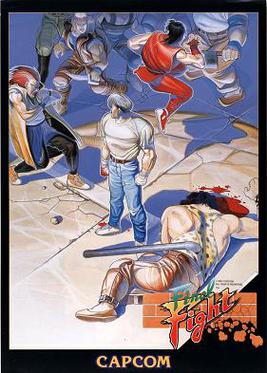
Final Fight is a 1989 beat 'em up game developed and published by Capcom for arcades, being the seventh title released for the CP System hardware. Set in the fictional Metro City, the player controls one of three street fighters: former pro wrestler and city mayor Mike Haggar, expert brawler Cody Travers, and modern-day ninja Guy. The trio set out to rescue Jessica when she is kidnapped by the Mad Gear Gang.
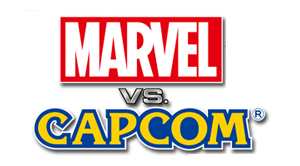
Marvel vs. Capcom is a series of crossover fighting games developed and published by Capcom, featuring characters from their own video game franchises and comic book series published by Marvel Comics. The series originated as coin-operated arcade games, though later releases would be specifically developed for home consoles, handhelds, and personal computers.

Super Street Fighter II Turbo, released in Japan as Super Street Fighter II X: Grand Master Challenge, and also known as Super Street Fighter II Turbo: The Ultimate Championship, is a fighting game released for the arcades by Capcom in Japan on February 23, 1994, in North America on February 23 and March 26, 1994 (beta) and in Europe in March 1994 (beta). It is the fifth installment in the Street Fighter II sub-series of Street Fighter games, following Super Street Fighter II: The New Challengers. Like its predecessor, it ran on the CP System II hardware.

Street Fighter Alpha 3, released as Street Fighter Zero 3 in Japan, Asia, South America, and Oceania, is a 2D fighting game originally released by Capcom for the arcade in 1998. It is the third and final installment in the Street Fighter Alpha sub-series, which serves as a sequel to Street Fighter Alpha 2, and ran on the same CP System II hardware as previous Alpha games. The game was produced after the Street Fighter III sub-series has started, being released after 2nd Impact, but before 3rd Strike. Alpha 3 further expanded the playable fighter roster from Street Fighter Alpha 2 and added new features such as selectable fighting styles called "isms".
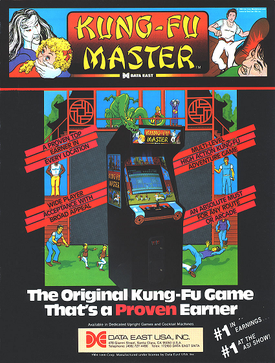
Kung-Fu Master, known as Spartan X in Japan, is a side-scrolling beat 'em up developed by Irem and released as an arcade video game in 1984. It was distributed by Data East in North America. Designed by Takashi Nishiyama, the game was based on Hong Kong martial arts films. It is a loose adaptation of the Jackie Chan, Sammo Hung and Yuen Biao film Wheels on Meals (1984), called Spartan X in Japan, with the protagonist Thomas named after Jackie Chan's character in the film. The game is also heavily inspired by the Bruce Lee film Game of Death (1972), which was the basis for the game's concept. Nishiyama, who had previously designed the side-scrolling shooter Moon Patrol (1982), combined fighting elements with a shoot 'em up gameplay rhythm. Irem and Data East exported the game to the West without the Spartan X license.

Nekketsu Kōha Kunio-kun, released as Renegade in the West, is a beat 'em up video game developed by Technōs Japan and distributed by Taito for the arcades in 1986. In the original Japanese version Nekketsu Kōha Kunio-kun, the game revolves around a high-school delinquent named Kunio-kun who must stand up against a series of rival gangs frequently targeting his classmate Hiroshi. In the Western version Renegade, the player controls a street brawler who must face four different gangs in order to rescue his girlfriend being held captive by a mob boss.

X-Men: Children of the Atom is an arcade game developed and published by Capcom and released on the CP System II arcade hardware in 1994 in Japan and in 1995 in North America and Europe.

Street Fighter is a 1987 arcade fighting game developed and published by Capcom. It is the first competitive fighting game produced by the company and the first installment in the Street Fighter series. It was a commercial success in arcades and introduced special attacks and some of the conventions made standard in later fighting games, such as the six-button controls and the use of command-based special moves.
A beat 'em up is a video game genre featuring hand-to-hand combat against a large number of opponents. Traditional beat 'em ups take place in scrolling, two-dimensional (2D) levels, while a number of modern games feature more open three-dimensional (3D) environments with yet larger numbers of enemies. The gameplay tends to follow arcade genre conventions, such as being simple to learn but difficult to master, and the combat system tends to be more highly developed than other side-scrolling action games. Two-player cooperative gameplay and multiple player characters are also hallmarks of the genre. Most of these games take place in urban settings and feature crime-fighting and revenge-based plots, though some games may employ historical, science fiction or fantasy themes.

Marvel vs. Capcom 2: New Age of Heroes is a crossover fighting game developed and published by Capcom. It is the fourth installment in the Marvel vs. Capcom series, which features characters from both Capcom's video game franchises and comic book series published by Marvel Comics. Originally released in Japanese arcades in 2000, the game received ports to the Dreamcast, PlayStation 2, PlayStation 3, Xbox, Xbox 360, and iOS devices over the span of twelve years.

The DECO Cassette System is an arcade system that was introduced by Data East in October 1980. It was the first standardised arcade system that allowed arcade owners to change games. Developed in 1979, it was released in Japan in 1980 and then North America in 1981.
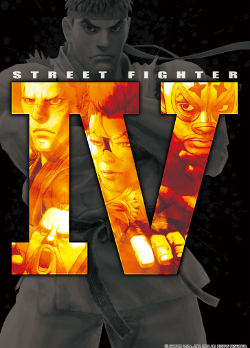
Street Fighter IV is a 2008 fighting game developed by Capcom and Dimps and published by Capcom. It was the first original main entry in the series since Street Fighter III in 1997, a hiatus of eleven years.
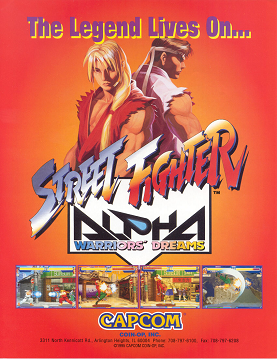
Street Fighter Alpha: Warriors' Dreams, known as Street Fighter Zero in Japan, Asia, South America, and Oceania, is a 2D arcade fighting game by Capcom originally released in 1995 for the CP System II hardware. It was the first all new Street Fighter game produced by Capcom since the release of Street Fighter II in 1991. The working title for the game was Street Fighter Legends.
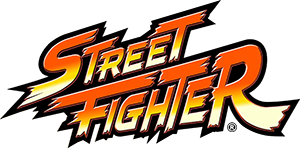
Street Fighter is a Japanese media franchise centered on a series of fighting games developed and published by Capcom. The first game in the series was released in 1987, followed by six other main series games, various spin-offs and crossovers, and numerous appearances in other media. Its best-selling 1991 release Street Fighter II established many of the conventions of the one-on-one fighting genre.

Street Fighter: The Movie is a 2D head-to-head fighting game developed by Capcom, released for the PlayStation and Sega Saturn in 1995, with the game serving as a North American launch title for the PlayStation. The game is based on the 1994 live-action Street Fighter movie, itself based on the Street Fighter series of fighting games, and uses digitized images of the film's cast as the characters. While it shares its title with the arcade game Street Fighter: The Movie, the home version is not a port but a similar game developed on the same premise. The game was a commercial success, but received widespread negative reception.

Capcom Fighting Jam, released in the US as Capcom Fighting Evolution, is a 2004 head-to-head fighting game from Capcom. It was originally released as a coin-operated arcade game for the Namco System 246 hardware and ported to the PlayStation 2 and Xbox. The game features characters from three different incarnations of the Street Fighter series, as well as characters from the Darkstalkers series and the CPS III arcade game Red Earth, with each character employing the fighting system from the game which they represent.
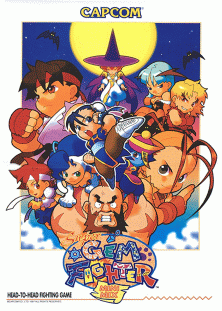
Super Gem Fighter Mini Mix, released in Japan as Pocket Fighter, is a fighting video game released by Capcom in 1997 for the CPS II arcade system. It was ported to the PlayStation, which retained the Pocket Fighter title for its North American and European releases, then the Sega Saturn and WonderSwan, as well as the PlayStation 2 as part of the Street Fighter Alpha-themed compilation title Street Fighter Alpha Anthology.
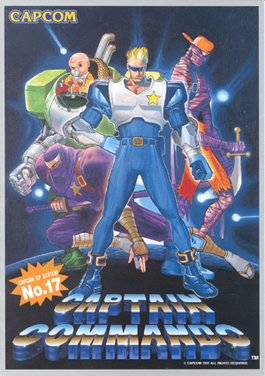
Captain Commando is a 1991 futuristic side-scrolling beat 'em up originally developed and published by Capcom as an arcade video game, and later ported to several other platforms. It was the seventeenth game produced for the company's CP System hardware. The game stars the titular superhero who was originally conceived as a fictional spokesman used by Capcom USA in the company's console games during the late 1980s. The game was included in Capcom Beat 'Em Up Bundle compilation title, which was released digitally for Nintendo Switch, PlayStation 4, Xbox One, and Windows on September 18, 2018.

















